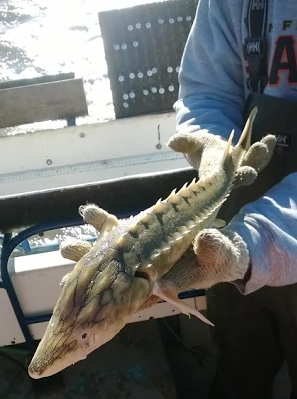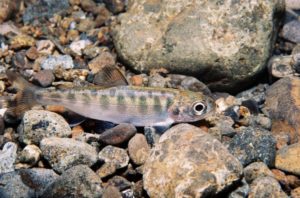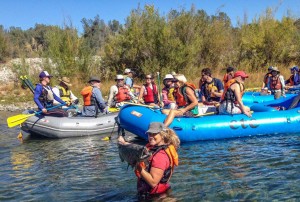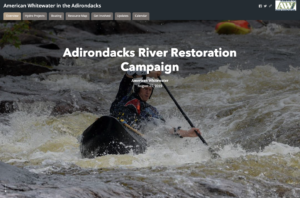Why Yuba Salmon, Steelhead and Sturgeon Matter Now
“If you don’t have nature, then you don’t have anything”
– Shelly Covert, Nevada City Rancheria Nisenan Tribal Spokesperson & Executive Director of California Heritage: Indigenous Research Project
Our beloved Yuba River, with its emerald green waters, Martianesque-boulder-lined banks, and deep history, is a treasure to all that swim in its waters and adventure along its banks. The river once supported massive runs of Chinook salmon and steelhead that were an important food source for local tribes, grizzly bears, and eagles, and that fertilized the forests with nutrients they brought from the ocean.
These fish once acted as keystone species that supported ecosystems from the Sierras to the sea. Legend says that the fish runs were so dense in the Yuba River that one could run across the water on the backs of salmon!
Today, Central Valley spring-run Chinook salmon, California Central Valley steelhead, and the green sturgeon are Federally listed as threatened species, and unfortunately their population trends continue to decline despite this listing (Table 1).
So, what happened? And what are we doing to reverse this trend?
The Gold Rush and Hydraulic Mining
Mining practices implemented during the Gold Rush were devastating for the river ecosystem. These techniques involved obliterating hillsides with hydraulic cannons, pouring waste mercury into the river by the pound, and ultimately dredging sections of the lower Yuba River that rerouted and suffocated it. It is estimated that 684 cubic yards of sediment were washed into the Yuba River during the Gold Rush, which is almost three times the amount of earth removed to carve the Panama Canal.
In addition to these harmfull practices, the massive influx of people into the watershed following the discovery of gold dramatically increased the demand for food, and salmon were an easy meal. One fisherman in 1878 noted the plight of salmon:
“After the female salmon escapes all her enemies in the ocean, the sea lions at the Golden Gate, the seals in the bay, and miles of nets in the river, and swims blindly against a stream of more than one hundred miles of muddy water thick with mining sediment and at last reaches the clean gravel beds of the ice-cold sources of the river to perform the duties of maternity, she is still beset by numerous enemies.”
These enemies include humans.
Hydraulic mining was phased out in 1884, but the damage this practice created caused further erosion. Decades later, in 1941, Englebright Dam was constructed on the lower Yuba River to prevent any more sediment from washing down. This dam also severed the river, preventing any salmon, steelhead, or sturgeon from making it up to their historic breeding grounds.

Population Numbers
Historically, these fish had access to all three forks of the Yuba River and were only impeded by natural barriers high in the watershed. Today, Daguerre Point Dam (river mile 11.5) blocks passage of green sturgeon and Englebright Dam (river mile 23.9) blocks passage of Chinook salmon and steelhead, effectively reducing their habitat in the Yuba River Watershed by 97%. The National Marine Fisheries Service (NMFS) lists the lower Yuba River as designated critical habitat for all three species.



Our Efforts
SYRCL’s Yuba Salmon Now Campaign envisions a day when wild salmon swim freely from the summit to the sea― liberated from the threat of extinction and restored to their ecological prominence in our natural heritage―and once again provide jobs, world-renowned fishing, and a source of healthy food. Through advocacy, science, restoration, and education programs, SYRCL leads a comprehensive effort to recover salmon, steelhead, and green sturgeon populations within the Yuba River watershed. Today, SYRCL is working to rehabilitate more than 250 acres of floodplain and side channel habitat for juvenile salmonids. In addition, SYRCL sends hundreds of local students each year on a rafting or hiking expedition to learn about salmon and the Yuba River watershed. Finally, SYRCL advocates for higher river flows, habitat restoration, fish passage over dams, and gravel augmentation with federal, state, and local agencies.
SYRCL’s Watershed Science Department is working in tandem with the Yuba Salmon Now campaign to conserve our native anadromous fish through restoration. Our restoration projects in the lower Yuba River respond directly to the recovery strategies outlined by NMFS for increasing anadromous fish populations in the lower Yuba River (Table 2). These efforts are already fruitful. Phase 1 of the Hallwood Restoration Project was completed in 2020. Since its completion we have observed salmon and steelhead spawning in the project site and juvenile salmon and steelhead rearing in the side channels!
Your support of SYRCL goes directly to these restoration and education efforts. Thank you for supporting us and the salmon, steelhead, and sturgeon that call the Yuba River home.
From our Resource Library
Decommissioning and removalReports
Stranded Midstream: Cause and Consequence of Hydropower Regulatory Delay


